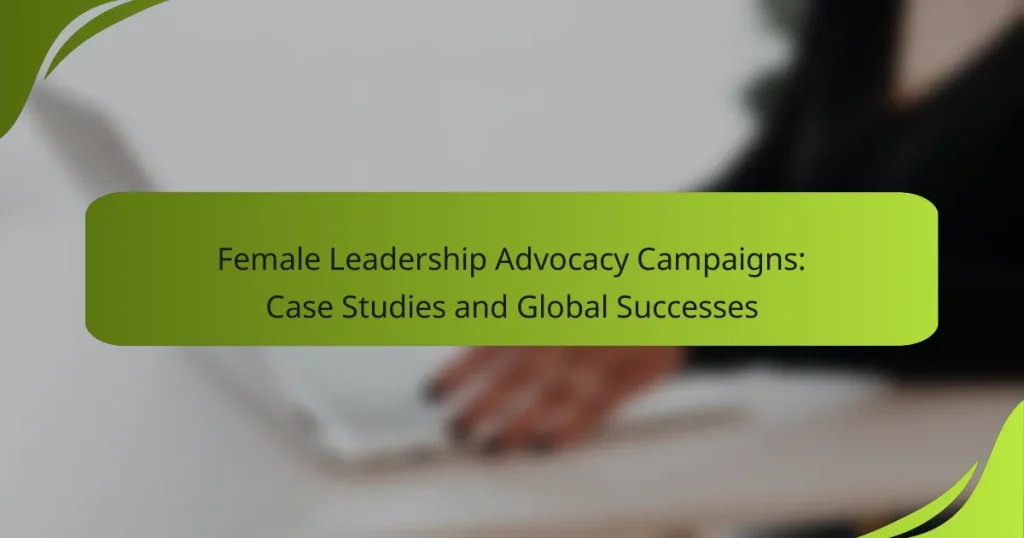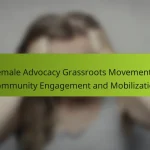Female leadership advocacy campaigns play a crucial role in empowering women and promoting gender equality in leadership roles worldwide. By engaging a diverse array of stakeholders, these initiatives create impactful change and pave the way for women to take on positions traditionally held by men, fostering a more equitable society.
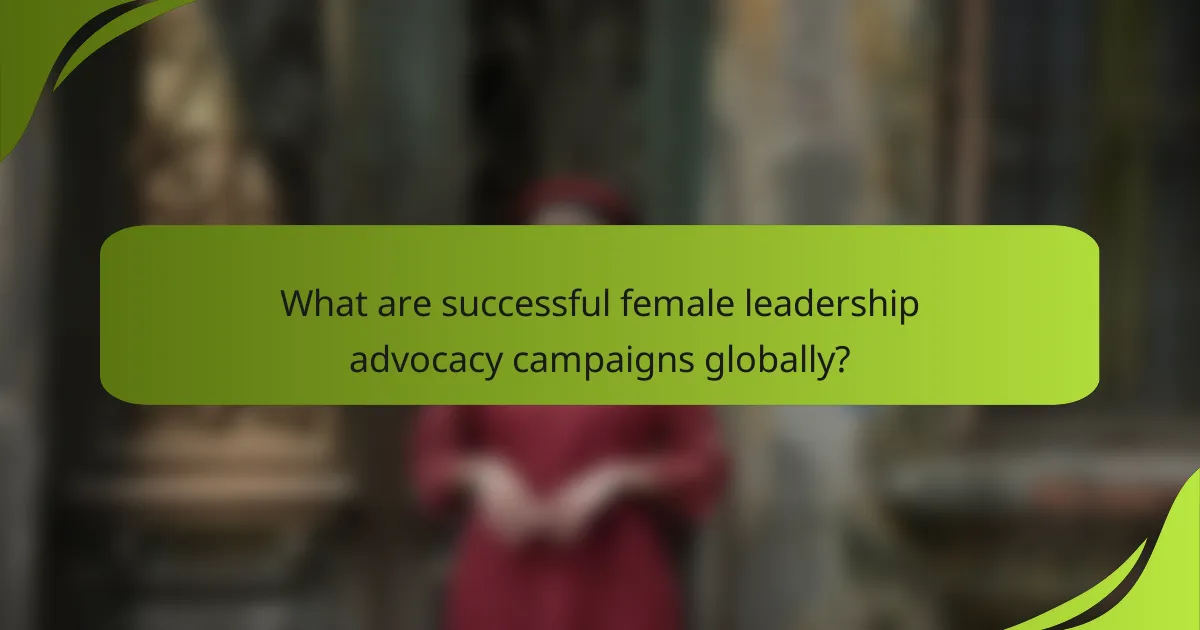
What are successful female leadership advocacy campaigns globally?
Successful female leadership advocacy campaigns globally focus on empowering women and promoting gender equality in leadership roles. These initiatives often engage diverse stakeholders, including individuals, organizations, and governments, to create impactful change and foster inclusive environments.
UN Women’s HeForShe Campaign
The HeForShe campaign, launched by UN Women, invites men and boys to advocate for gender equality alongside women. This initiative emphasizes that gender equality is not solely a women’s issue but a human rights issue that requires collective action.
HeForShe has mobilized millions of individuals worldwide, encouraging them to commit to gender equality through personal pledges and community actions. The campaign’s focus on male allies has proven effective in shifting cultural norms and increasing awareness about the importance of female leadership.
Lean In Circles
Lean In Circles are small, peer support groups that encourage women to share experiences and challenges in their professional lives. Founded by Sheryl Sandberg, this initiative aims to create a community where women can empower each other to pursue their ambitions and develop leadership skills.
These circles provide a structured environment for discussions, networking, and skill-building. Participants often report increased confidence and a stronger sense of belonging in their workplaces, which can lead to greater representation of women in leadership roles.
Women in Leadership Nexus
The Women in Leadership Nexus is a global network that connects women leaders and advocates to share resources, strategies, and best practices. This initiative focuses on fostering collaboration among women across various sectors to enhance their leadership capabilities.
By providing access to mentorship, training programs, and networking opportunities, the Nexus aims to break down barriers that women face in leadership positions. Participants can leverage these connections to advance their careers and promote gender equity in their organizations.
Girl Up Campaign
Girl Up is a United Nations Foundation initiative that empowers young girls to become leaders and advocates for gender equality. The campaign focuses on educating and mobilizing girls to take action on issues affecting their communities and beyond.
Through leadership training, advocacy campaigns, and community service projects, Girl Up encourages girls to develop their skills and confidence. The initiative also highlights the importance of girls’ voices in shaping policies that impact their lives, fostering a new generation of female leaders.
Women’s March Global Initiatives
The Women’s March Global Initiatives aim to unite individuals around the world in advocating for women’s rights and social justice. These initiatives focus on mobilizing communities to address issues such as gender-based violence, reproductive rights, and equal pay.
Through organized marches, educational events, and advocacy campaigns, the Women’s March encourages grassroots activism and empowers women to take action in their local contexts. This global movement has successfully raised awareness and inspired collective action for female leadership and equality.
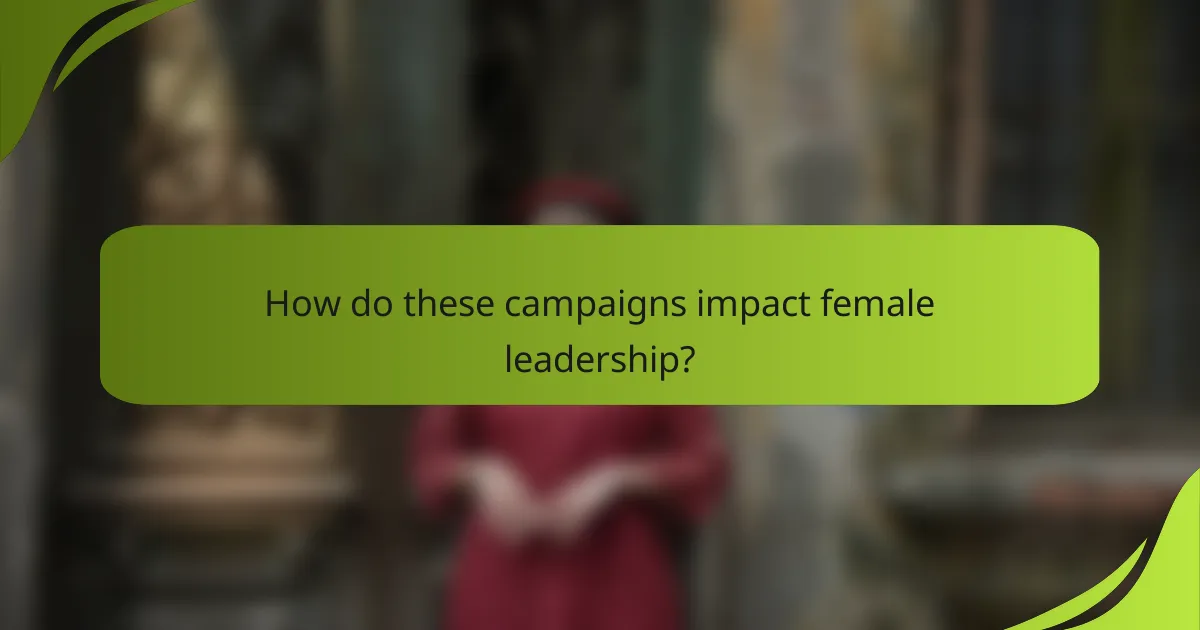
How do these campaigns impact female leadership?
Female leadership advocacy campaigns significantly enhance the presence and influence of women in leadership positions. They create pathways for women to ascend to roles traditionally dominated by men, fostering a more equitable workplace and society.
Increased representation in leadership roles
These campaigns often lead to a measurable increase in the number of women in leadership positions across various sectors. For instance, organizations that implement targeted initiatives may see female representation in executive roles rise from low double digits to over 30% within a few years.
Furthermore, such advocacy can encourage companies to adopt policies that support gender diversity, such as mentorship programs and flexible work arrangements. These changes not only benefit women but can also enhance overall organizational performance.
Enhanced visibility of gender issues
Advocacy campaigns shine a spotlight on gender-related challenges that women face in the workplace, such as pay gaps and workplace harassment. By raising awareness, these initiatives encourage public discourse and prompt organizations to address these issues more proactively.
For example, campaigns that highlight the gender pay gap can lead to increased transparency in salary structures, prompting companies to conduct pay audits and adjust compensation accordingly. This visibility can drive systemic changes that benefit all employees.
Empowerment through community support
Community support is a cornerstone of successful female leadership campaigns, providing women with networks that foster growth and collaboration. These networks often include mentorship opportunities, workshops, and forums for sharing experiences and strategies.
Additionally, engaging in community-driven initiatives can empower women to take on leadership roles by building confidence and skills. Programs that connect aspiring leaders with established professionals can create a supportive environment that nurtures future female leaders.
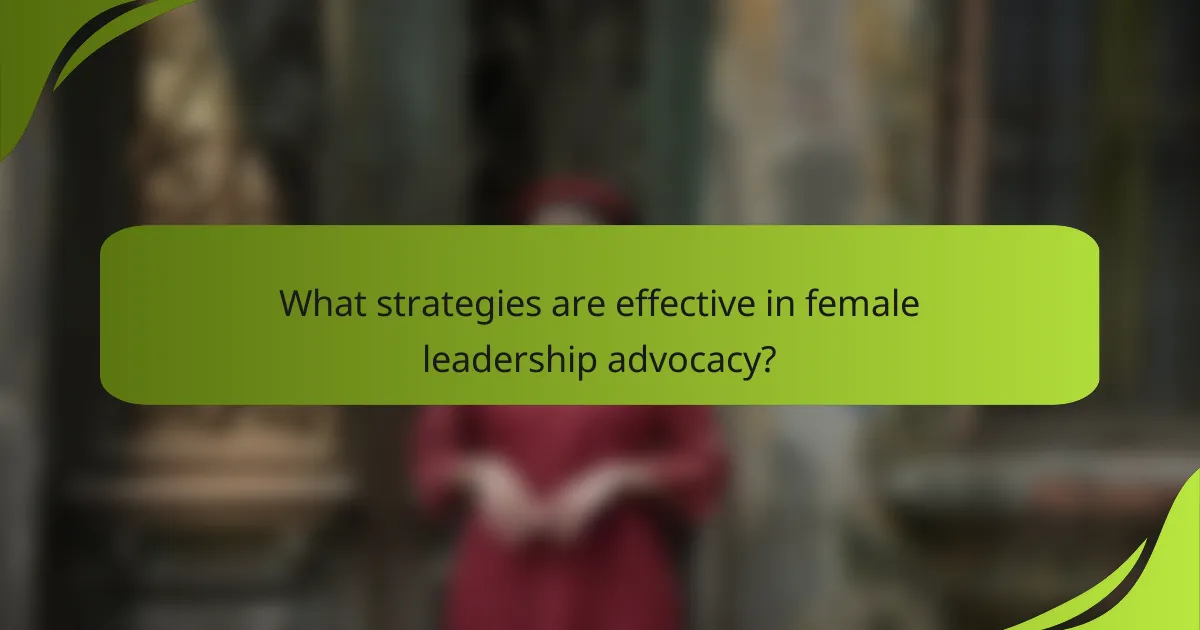
What strategies are effective in female leadership advocacy?
Effective strategies for female leadership advocacy include implementing mentorship programs, creating networking opportunities, and launching public awareness initiatives. These approaches empower women, enhance their visibility, and foster supportive environments that encourage leadership development.
Mentorship programs
Mentorship programs connect aspiring female leaders with experienced professionals who can provide guidance and support. These programs often involve one-on-one relationships where mentors share insights, offer advice, and help mentees navigate their career paths.
Successful mentorship initiatives typically include structured meetings, goal-setting, and feedback sessions. Organizations can enhance these programs by pairing mentors and mentees based on industry, interests, or career goals, ensuring a more tailored experience.
Networking opportunities
Networking opportunities are crucial for women to build connections, share experiences, and access resources. Events like conferences, workshops, and informal meetups allow women to expand their professional circles and discover new career prospects.
To maximize the benefits of networking, participants should prepare an elevator pitch, actively engage in discussions, and follow up with new contacts. Organizations can facilitate networking by hosting events that focus on female leadership themes, creating safe spaces for open dialogue.
Public awareness initiatives
Public awareness initiatives aim to highlight the importance of female leadership and challenge stereotypes. Campaigns can include social media outreach, community events, and partnerships with influential organizations to amplify messages about gender equality in leadership roles.
These initiatives should focus on storytelling, showcasing successful female leaders and their journeys. Engaging content, such as videos and articles, can resonate with diverse audiences, inspiring them to support female leadership and advocate for change in their communities.
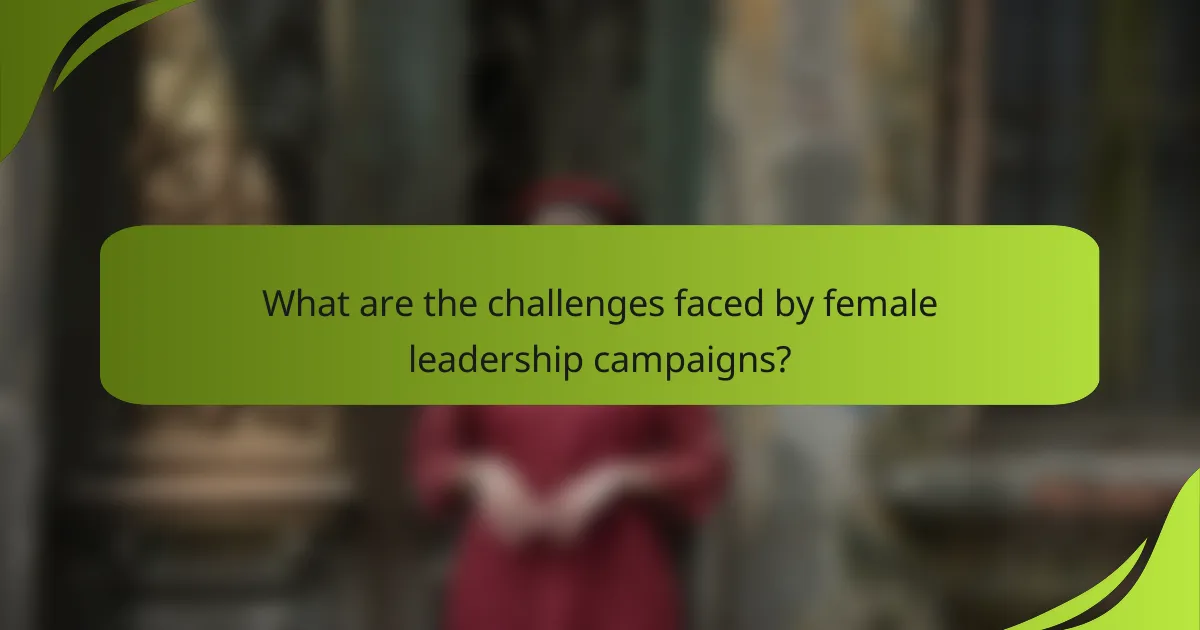
What are the challenges faced by female leadership campaigns?
Female leadership campaigns encounter several significant challenges that hinder their effectiveness. These include societal stereotypes, lack of funding and resources, and resistance to change within corporate cultures.
Societal stereotypes
Societal stereotypes often portray women as less capable leaders compared to their male counterparts. These biases can manifest in various forms, such as assumptions about women’s commitment to their careers or their ability to make tough decisions.
To combat these stereotypes, campaigns can focus on showcasing successful female leaders and their achievements. Highlighting relatable role models can help shift public perception and inspire future generations of women leaders.
Lack of funding and resources
Many female leadership initiatives struggle with securing adequate funding and resources, which are essential for their success. Limited financial support can restrict the reach and impact of campaigns aimed at promoting women in leadership roles.
To address this issue, organizations should seek partnerships with businesses and philanthropic entities that prioritize gender equality. Creating a clear value proposition for potential funders can also enhance the likelihood of obtaining necessary resources.
Resistance to change in corporate culture
Resistance to change within corporate cultures can significantly impede female leadership campaigns. Many organizations have entrenched practices and mindsets that favor traditional leadership models, making it difficult for women to ascend to leadership positions.
To overcome this resistance, campaigns should advocate for comprehensive diversity and inclusion training within companies. Additionally, implementing mentorship programs can help foster an environment that supports women’s advancement in leadership roles.
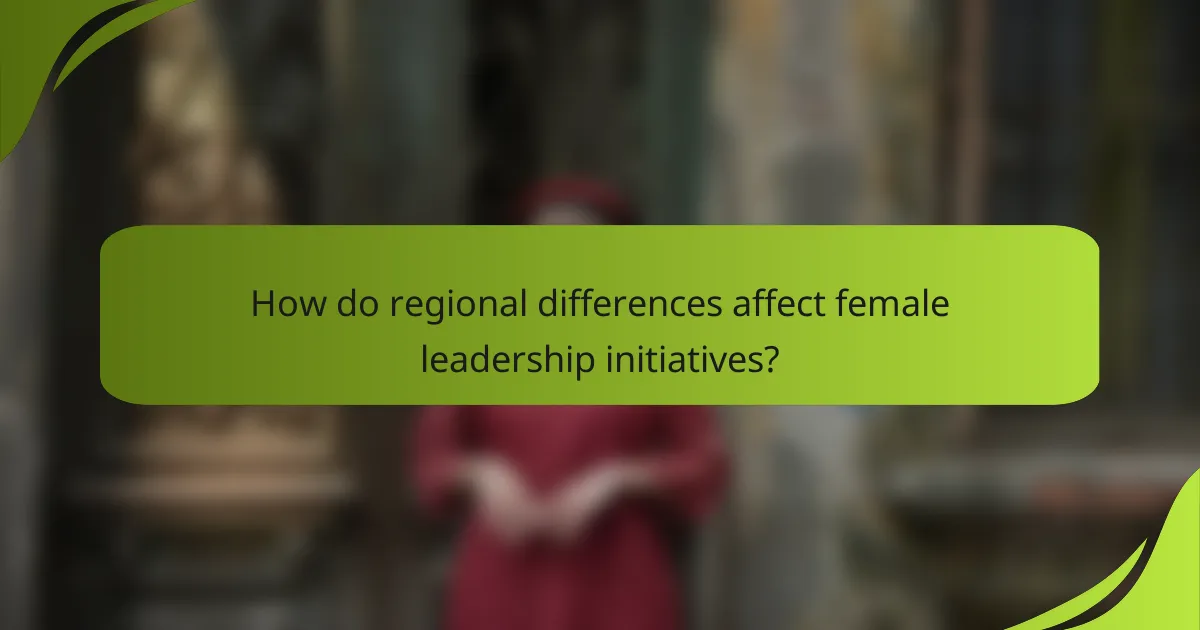
How do regional differences affect female leadership initiatives?
Regional differences significantly influence female leadership initiatives through varying cultural attitudes, legal frameworks, and access to education. These factors can either promote or hinder women’s advancement in leadership roles, shaping the effectiveness of advocacy campaigns.
Variations in cultural attitudes
Cultural attitudes towards women in leadership roles differ widely across regions. In some cultures, traditional gender roles may limit women’s opportunities, while in others, progressive views encourage female participation in leadership. For instance, Nordic countries often exhibit high levels of gender equality, promoting women in leadership, whereas certain regions in South Asia may still grapple with deeply rooted patriarchal norms.
Understanding these cultural nuances is crucial for tailoring advocacy campaigns. Campaigns that resonate with local values and beliefs are more likely to succeed. Engaging community leaders and influencers can help shift perceptions and foster a supportive environment for female leaders.
Legal frameworks and policies
Legal frameworks play a critical role in shaping female leadership initiatives. Countries with strong gender equality laws, such as equal pay and anti-discrimination policies, create a more favorable environment for women to ascend to leadership positions. In contrast, regions lacking such regulations may see slower progress in female representation.
For example, countries in the European Union have implemented various directives aimed at promoting gender equality in the workplace, while some regions in the Middle East may have limited legal protections for women. Advocacy efforts should focus on pushing for legal reforms that support women’s leadership and ensure compliance with international standards.
Access to education and training
Access to education and training is a fundamental factor affecting female leadership. Regions with higher educational attainment for women tend to see greater representation in leadership roles. However, disparities in access to quality education can hinder women’s progress in many parts of the world.
For instance, Sub-Saharan Africa faces significant challenges in providing girls with equal educational opportunities, which directly impacts their ability to pursue leadership positions. Advocacy campaigns should prioritize initiatives that enhance educational access and provide leadership training programs tailored for women, ensuring they have the skills and confidence needed to lead effectively.
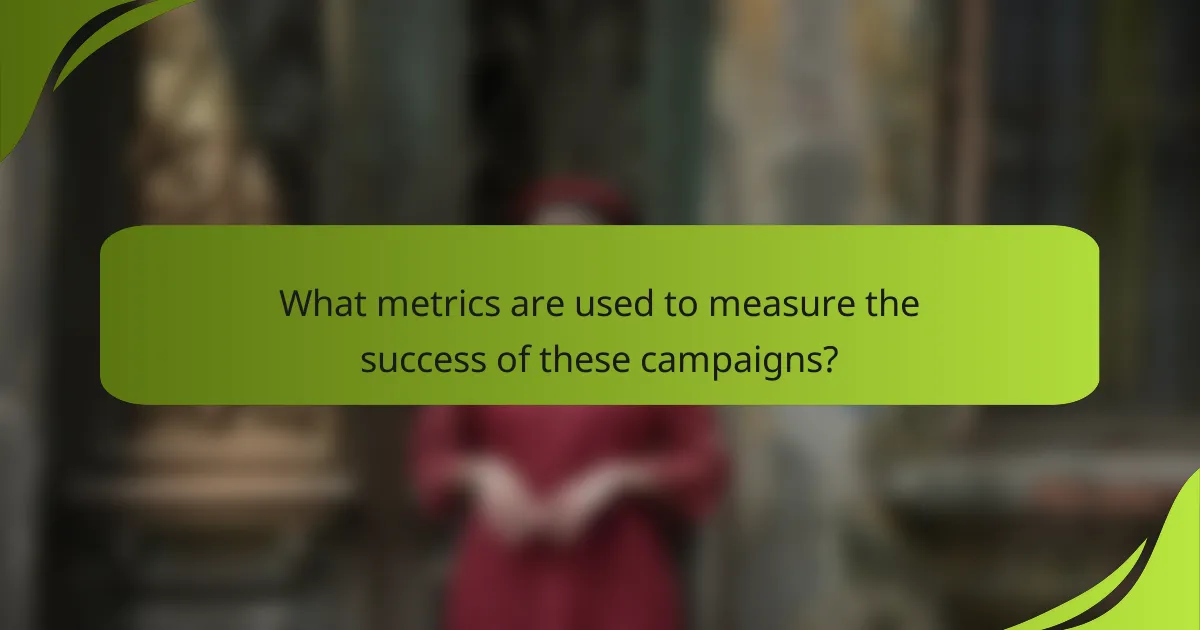
What metrics are used to measure the success of these campaigns?
Success metrics for female leadership advocacy campaigns often include participation rates, leadership representation, and impact assessments. These metrics help organizations evaluate the effectiveness of their initiatives and identify areas for improvement.
Participation Rates
Participation rates indicate how many individuals engage with the campaign, whether through events, workshops, or online platforms. High participation rates suggest strong interest and engagement, which can lead to greater awareness and support for female leadership initiatives.
To measure participation, organizations can track attendance numbers, online engagement metrics, and feedback surveys. For example, a campaign may aim for a participation rate of 50% among targeted demographics, such as women in specific industries or regions.
Leadership Representation
Leadership representation metrics assess the proportion of women in leadership roles within organizations or sectors targeted by the campaign. This can include tracking the percentage of women in executive positions, board memberships, and other leadership roles.
Organizations may set specific goals, such as increasing female representation in leadership by 10% over a defined period. Regular reporting on these metrics can help maintain accountability and transparency in efforts to promote female leadership.
Impact Assessments
Impact assessments evaluate the broader effects of advocacy campaigns on organizational culture and community attitudes toward female leadership. This can involve qualitative measures, such as interviews and focus groups, alongside quantitative data like employee satisfaction scores.
For effective impact assessments, organizations should establish baseline metrics before the campaign and compare them to post-campaign data. This approach allows for a clearer understanding of the campaign’s influence on perceptions and behaviors regarding female leadership.
